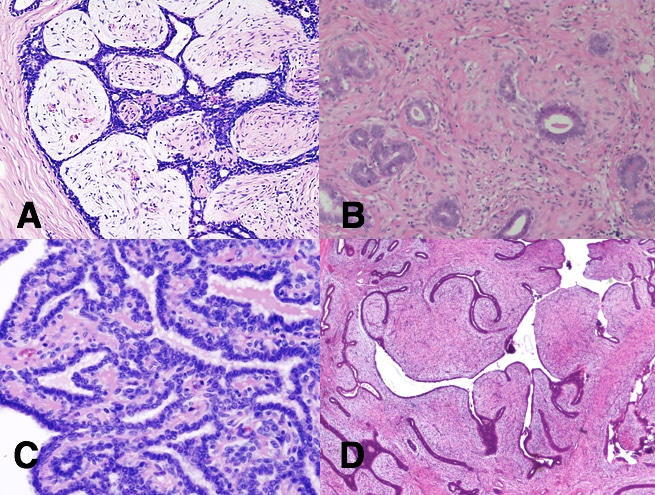Introduction
Breast lumps are a common presenting complaint and the majority are benign. Naturally, breast lumps can cause a certain degree of anxiety amongst patients due to concerns over malignancy; importantly, all new breast lumps should be examined, imaged, and if required biopsied as appropriate.
Types of Benign Tumours
Fibroadenoma
Fibroadenoma is the most common benign growth in the breast and usually occurs in women of a reproductive age. They are proliferations of stromal and epithelial tissue of the duct lobules.
On examination, they are highly mobile lesions (historically termed a “breast mouse”) that are well-defined and rubbery on palpation, with most less than 5cm in diameter. They can be multiple and bilateral.
They have a very low malignant potential and can be left in situ; indeed most fibroadenomas will stay the same or get smaller. The main indications for potential excision are >5cm in diameter or a sudden increase in size.
Adenoma
A ductal adenoma is a rare benign glandular tumour, typically occurring in the older female population. The lesions themselves are nodular and can easily mimic malignancy, therefore all cases will undergo triple assessment.
Papilloma
Intraductal papillomas are a benign breast lesion that usually occur in females in their 40-50s, most typically occurring in the subareolar region (usually less than 1cm away from the nipple).
They will often present with bloody nipple discharge, yet larger papillomas can also present initially as a mass.
They can appear similar to ductal carcinomas on imaging and therefore usually require biopsy. Some cases may be excised to ensure no atypical cells or neoplasia are present. There is a slight increase in lifetime risk of breast cancer with multi-ductal papillomas.
Lipoma
A breast lipoma is a soft and mobile benign adipose tumour that are normally otherwise asymptomatic. They have very low malignant potential and are usually only removed if they are significantly enlarging or causing discomfort.
Phyllodes Tumours
Phyllodes tumours* are rare fibroepithelial tumours. Phyllodes tumours are commonly larger and occur in an older age group than fibroadenomas. They are comprised of both epithelial and stromal tissue and can grow rapidly.
They are difficult to clinically and microscopically differentiate from fibroadenomas. Most are still benign, however around one third of Phyllodes tumours have malignant potential. Treatment for Phyllodes tumours is surgical removal but they should be widely excised because they can recur even after excision.
*The name derives from the Greek word ‘phyllodes’ meaning leaf, due to its characteristic leaf like projections of fibrous tissue seen on microscopy
Clinical Features
As described above, benign breast lesions can present in a variety of ways.
However in general, benign breast lumps tend to be more mobile and have smoother borders than their malignant counterparts, which often have craggy surfaces, a firm consistency, and can be fixed to different layers of tissue.
Malignant lesions tend to present as a single mass, whilst it is possible to get multiple benign breast lumps.
Differential Diagnosis
The mainstay of distinguishing between breast lumps is the Triple Assessment. The main differentials to consider include cysts, fibroadenomas, and malignant lesions.
Investigations and Management
All suspicious breast lesions should undergo the triple assessment, warranting examination, imaging, and histology.
Most confirmed cases of benign breast lumps can be reassured and discharged. However, if a breast lump cannot be confirmed to be benign or has malignant potential with atypical cells, they may be excised after a triple assessment and MDT discussion
Benign breast lumps may be offered excision if they cause symptoms, such as pain or discomfort.
Key Points
- The majority of breast lumps are benign
- Common benign tumour subtypes include Fibroadenoma, Adenoma, Papilloma, Lipoma, and Phyllodes Tumours
- All suspicious lumps should undergo triple assessment and be discussed at the breast MDT to form a management plan

